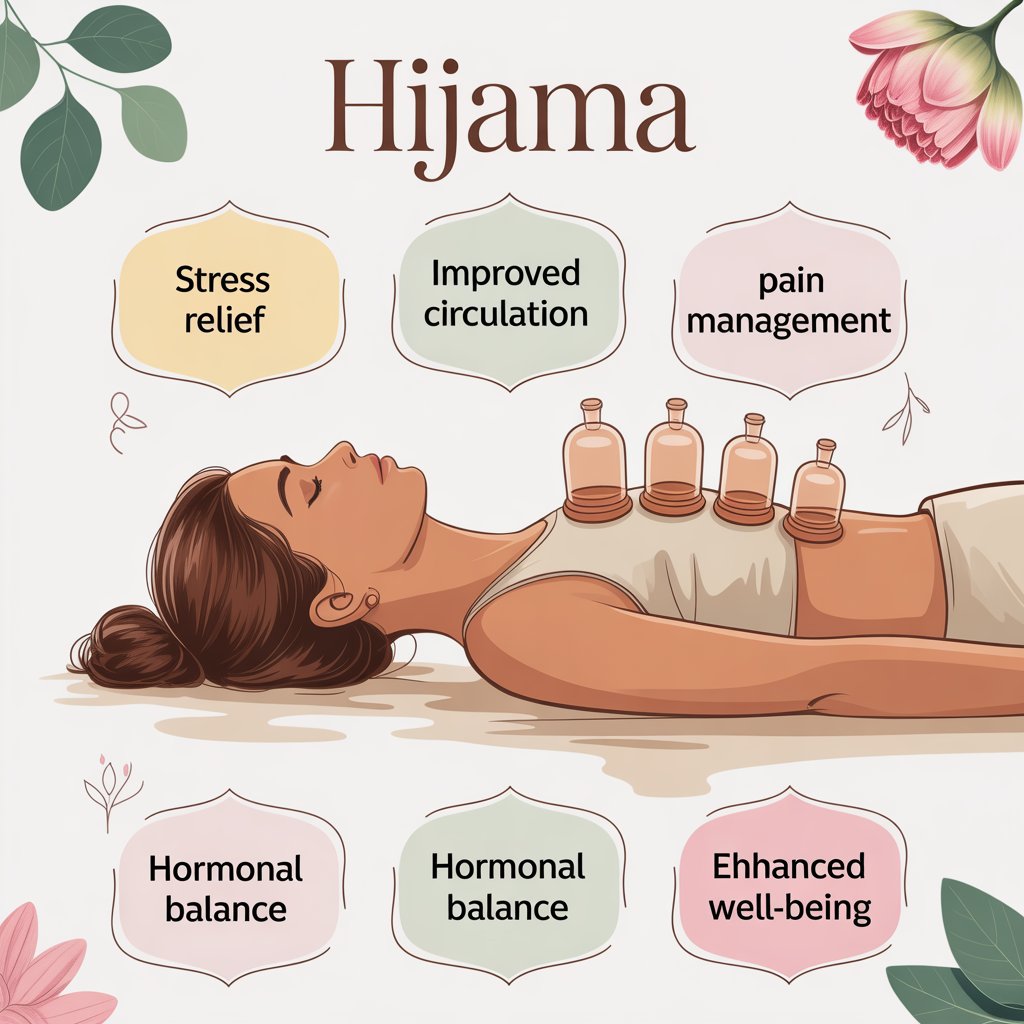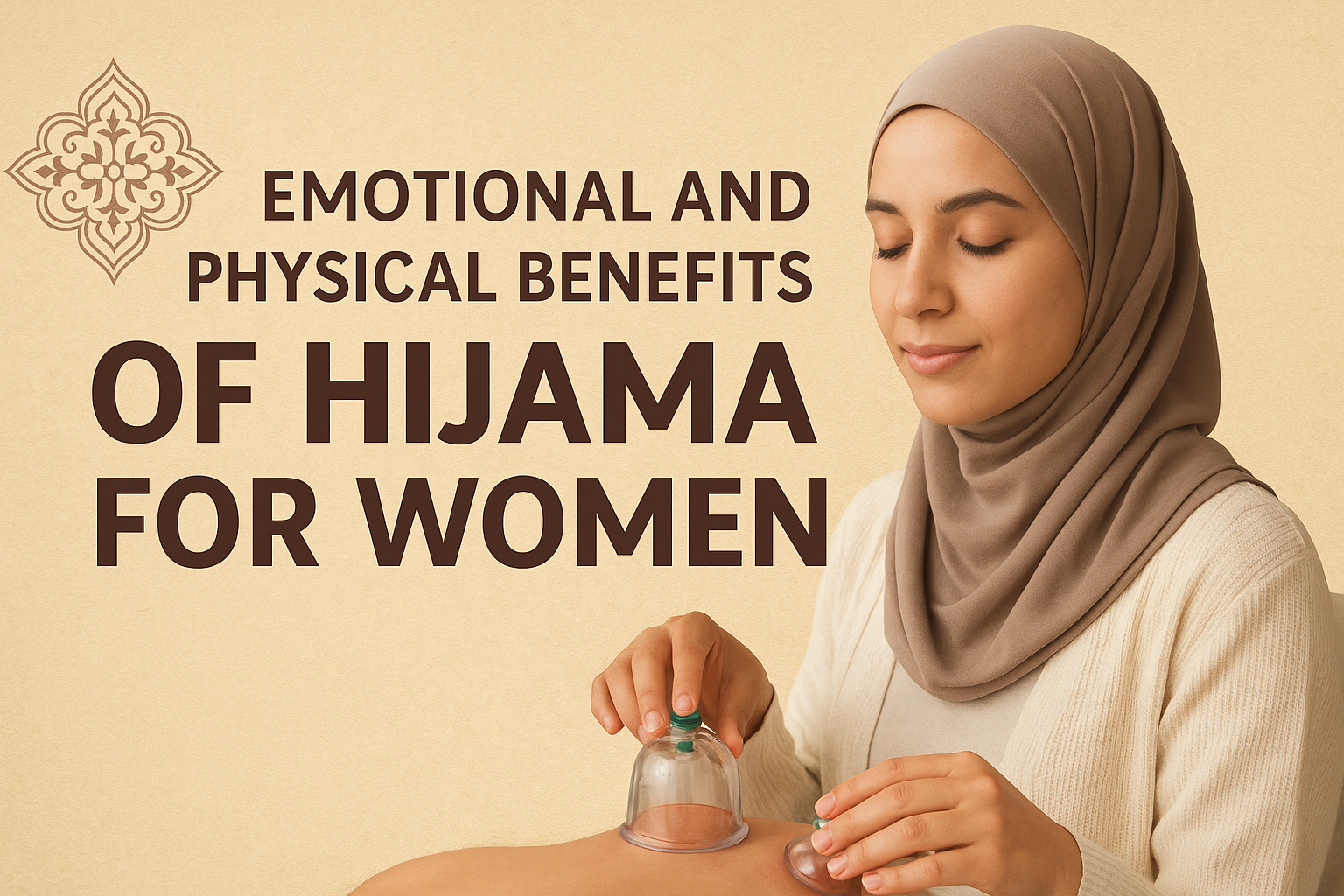No products in the cart.
Emotional and Physical Benefits of Hijama for Women
Women today often carry double the weight — balancing careers, families, and personal wellbeing. Over time, this physical and emotional load builds tension in the body and drains mental energy. In recent years, many women in Canada have turned to Hijama (wet cupping therapy) as a safe and natural way to restore balance, improve health, and find relief from daily stress.
Hijama is not a new discovery. It is a centuries-old therapeutic practice, deeply rooted in prophetic and traditional medicine. What’s changed today is how modern practitioners apply it safely in clean, clinical settings combining ancient wisdom with modern hygiene and care.
This article explores the emotional and physical benefits of Hijama for women and how it can become part of your wellness routine.

What Is Hijama?
Hijama, or wet cupping therapy, is a natural healing method where suction cups are applied to specific areas of the body to draw out stagnant blood and toxins. The mild suction improves circulation, reduces inflammation, and stimulates the body’s own healing mechanisms.
Unlike dry cupping (which uses suction only), wet cupping involves making tiny, controlled incisions on the skin before applying the cups again. The goal is not to cause pain or blood loss, but to clear sluggish, toxin-filled blood and encourage new, oxygen-rich blood to circulate.
When performed by a certified practitioner, the process is quick, sterile, and deeply relaxing often leaving women feeling lighter and calmer almost instantly.
1. Hormonal and Menstrual Support
Many women struggle with irregular periods, painful cramps, fatigue, and mood changes linked to hormonal imbalance. Hijama helps by stimulating blood flow and improving lymphatic drainage, which can support hormonal regulation naturally.
Women who receive regular Hijama sessions often report:
- Relief from menstrual cramps and lower-back pain
- More regular menstrual cycles
- Less bloating and fatigue before or during periods
- Improved mood stability and energy levels
Hijama does not replace medical treatment for severe hormonal issues, but it can work alongside lifestyle changes and medical care to support better reproductive health.
2. Fertility and Reproductive Wellness
Hijama has been used for centuries to support fertility and reproductive wellness in women. The therapy helps detoxify the body, reduces inflammation around the reproductive organs, and promotes balanced hormone production.
By increasing blood circulation to the ovaries and uterus, Hijama may:
- Support ovulation naturally
- Reduce pelvic congestion
- Improve uterine health and lining thickness
- Help manage stress, which is often a silent factor in fertility challenges
In Canada, many holistic health practitioners now include Hijama as part of fertility support programs because of its gentle, non-invasive nature and its ability to help the body restore internal balance.
3. Pain Relief and Muscle Recovery
Chronic pain — whether from posture, desk work, or physical activity — affects many women. Hijama targets areas where tension builds up, such as the neck, shoulders, and lower back.
The suction action draws fresh blood to sore or stiff muscles, releasing tightness and improving tissue repair. For women dealing with:
- Back and neck pain
- Shoulder stiffness
- Migraines
- Muscle fatigue after workouts
…Hijama can be a soothing, drug-free solution. It’s especially helpful for postpartum women or those who experience body aches due to hormonal changes.
4. Detoxification and Skin Health
Hijama is known as a natural detox tool. It helps the body eliminate waste and stagnant blood that may contribute to fatigue, sluggishness, or dull skin.
After a few sessions, many women notice:
- Healthier, brighter skin tone
- Fewer breakouts
- Improved energy and digestion
- A general sense of “lightness” in the body
The process stimulates the lymphatic system and enhances metabolism, helping your body flush out what it doesn’t need — naturally and safely.
5. Support During Life Changes
Every stage of a woman’s life brings unique challenges. Hijama can be customized for each phase:
- Postpartum recovery: Helps relieve tension, improve blood flow, and speed up recovery after childbirth.
- Menopause: May ease hot flashes, mood changes, and sleep disturbances by promoting hormonal balance and reducing stress.
- Busy lifestyle fatigue: Regular Hijama sessions can help reduce burnout symptoms and improve overall energy levels.
Emotional and Mental Benefits of Hijama for Women
1. Deep Stress Relief
In today’s fast-paced life, stress affects women’s mental and physical health more than ever. The gentle suction during Hijama stimulates nerve endings and encourages relaxation. Many women describe it as a full-body reset — like releasing built-up emotional pressure.
After a session, it’s common to feel calmer, lighter, and more emotionally centered. The therapy helps regulate cortisol (the stress hormone) and encourages the release of endorphins — the body’s natural “feel-good” chemicals.
2. Emotional Balance and Mental Clarity
Hormonal shifts often influence mood, anxiety levels, and focus. By improving circulation and reducing inflammation, Hijama indirectly supports emotional balance.
Women who receive Hijama regularly often notice:
- A calmer emotional state
- Better concentration and sleep
- Relief from mild anxiety or mental fatigue
The quiet, meditative nature of the session itself also creates mental space — helping women reconnect with their bodies and emotions in a grounding, healing way.
3. Empowerment and Self-Care
Beyond physical healing, Hijama represents self-respect and mindful care. In many cultures, it’s a form of self-renewal — taking time to cleanse the body and honor its needs.
For Canadian women balancing work, family, and social responsibilities, this kind of intentional self-care is vital. Each session becomes a reminder that healing doesn’t have to come from medication alone — sometimes, it’s about giving your body what it naturally needs to function at its best.
Safety and Professional Care
Hijama should always be done by a trained and certified practitioner who follows strict hygiene protocols. At Hijama Natural Healing, every session is conducted using sterilized cups, medical-grade equipment, and a calm, private environment where women can feel comfortable and safe.
Women should inform their practitioner if they are pregnant, breastfeeding, taking medication, or managing a health condition. The therapy can be adapted or postponed if necessary.
Minor redness or mild marks after cupping are normal and usually fade within a few days — showing that circulation has improved in those areas.

How Often Should You Do Hijama?
For most women, once every three to six months is ideal for general wellness and stress relief.
If the goal is hormonal balance, fertility support, or pain management, your practitioner may recommend a short series of sessions — spaced out safely to allow your body to recover and adjust.
Consistency, rather than frequency, is key. Over time, many women notice lasting benefits in energy, mood, and physical wellbeing.
Final Thoughts
Hijama is more than a physical treatment — it’s a holistic approach to health that aligns body, mind, and spirit. For women in Canada seeking a natural way to manage stress, balance hormones, ease pain, or simply feel more energized, Hijama offers a safe and proven path.
When performed under professional care, this ancient practice becomes a modern tool for emotional healing, physical recovery, and inner renewal.
At Hijama Natural Healing, every session is designed to support your individual journey restoring your natural state of balance and helping you feel your best, inside and out.
Ready to Experience Hijama for Yourself?
Book your consultation today with Hijama Natural Healing and discover how this time-honoured therapy can help you achieve lasting emotional and physical wellbeing.




Leave a Reply